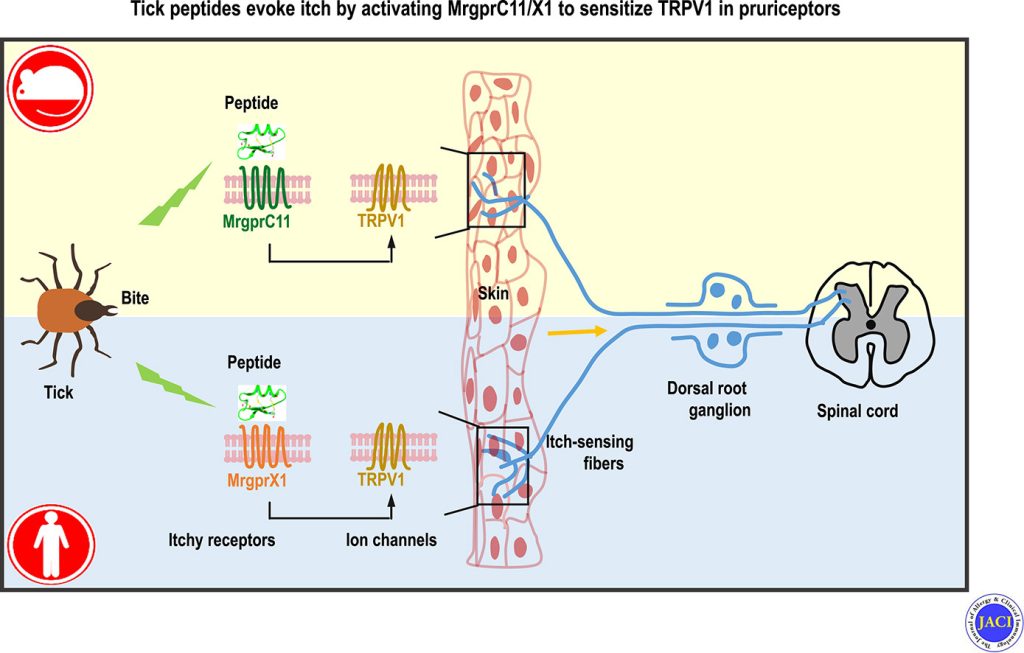Journal Club 25.12.08
Therapeutic effect of an MRGPRX2/MRGPRB2 antagonist on LL-37-induced rosacea-like inflammation in mice
Billy Kwok Chong Chow # 1 2 3, Ye Gi Choi # 4, Trevor K Wong # 4 5, Shaik Abdullah Nawabjan 6, Kesang Li 7, Mukesh Kumar 8
- 1Ningbo No.2 Hospital, Ningbo, Zhejiang, China. bkcc@hku.hk.
- 2Guoke Ningbo Life Science and Health Industry Research Institute, Ningbo, Zhejiang, China. bkcc@hku.hk.
- 3School of Biological Sciences, The University of Hong Kong, Pok Fu Lam Road, Pok Fu Lam, Hong Kong, China. bkcc@hku.hk.
- 4School of Biological Sciences, The University of Hong Kong, Pok Fu Lam Road, Pok Fu Lam, Hong Kong, China.
- 5Faculty of Health Sciences, McMaster University, Hamilton, ON, L8S 4L8, Canada.
- 6School of Biological Sciences, The University of Hong Kong, Pok Fu Lam Road, Pok Fu Lam, Hong Kong, China. shaik@connect.hku.hk.
- 7Ningbo No.2 Hospital, Ningbo, Zhejiang, China.
- 8School of Biological Sciences, The University of Hong Kong, Pok Fu Lam Road, Pok Fu Lam, Hong Kong, China. mkumar@connect.hku.hk.
#Contributed equally.
https://doi.org/10.1007/s00011-025-02144-y
Abstract
Introduction
Rosacea is a chronic inflammatory skin disorder characterized by symptoms like itching, redness, and impaired skin barrier function. Mast cell activation plays a crucial role in its pathogenesis. Recent evidence shows higher expression of mast cell receptor MRGPRX2/MRGPRB2 in rosacea patients’ skin tissues and its potential as a novel drug target. We evaluated the therapeutic effect of a novel small-molecule MRGPRX2/MRGPRB2 antagonist in a mouse model of rosacea and itch.
Methods
The therapeutic effects of GE1111 were evaluated in vivo on wildtype and MRGPRB2 knock-out mice with LL-37-induced rosacea. Serum MCP-1 level and histochemistry measured inflammation and mast cell degranulation in skin tissue. Functional in vitro cell culture assays were developed using MRGPRX2/MRGPRB2 agonist LL-37, mast cells, keratinocytes, and macrophage cell lines.
Results
LL-37-treated mice showed redness, increased serum MCP-1, and epidermal thickness of skin tissue, while these changes were absent in LL-37-treated MRGPRB2 knock-out mice. Treatment with GE1111 reduced rosacea symptoms, epidermal thickness, and serum MCP-1 levels. GE1111 protected tight junction protein expression and reduced mast cell degranulation and inflammatory cytokine gene and protein expression in skin lesions. GE1111 treatment reduced the number and duration of itch in the compound 48/80 induced itch model. In vitro evidence showed GE1111’s mechanism by inhibiting inflammatory interaction of mast cells with keratinocytes and macrophages.
Conclusion
GE1111 showed promising therapeutic effects in rosacea via targeting interactions between mast cells, keratinocytes, and macrophages and inhibiting inflammatory cytokines. These findings open possibilities for developing MRGPRX2/MRGPRB2 antagonists as novel treatments for rosacea.
Journal Club 25.12.08 Read More »


